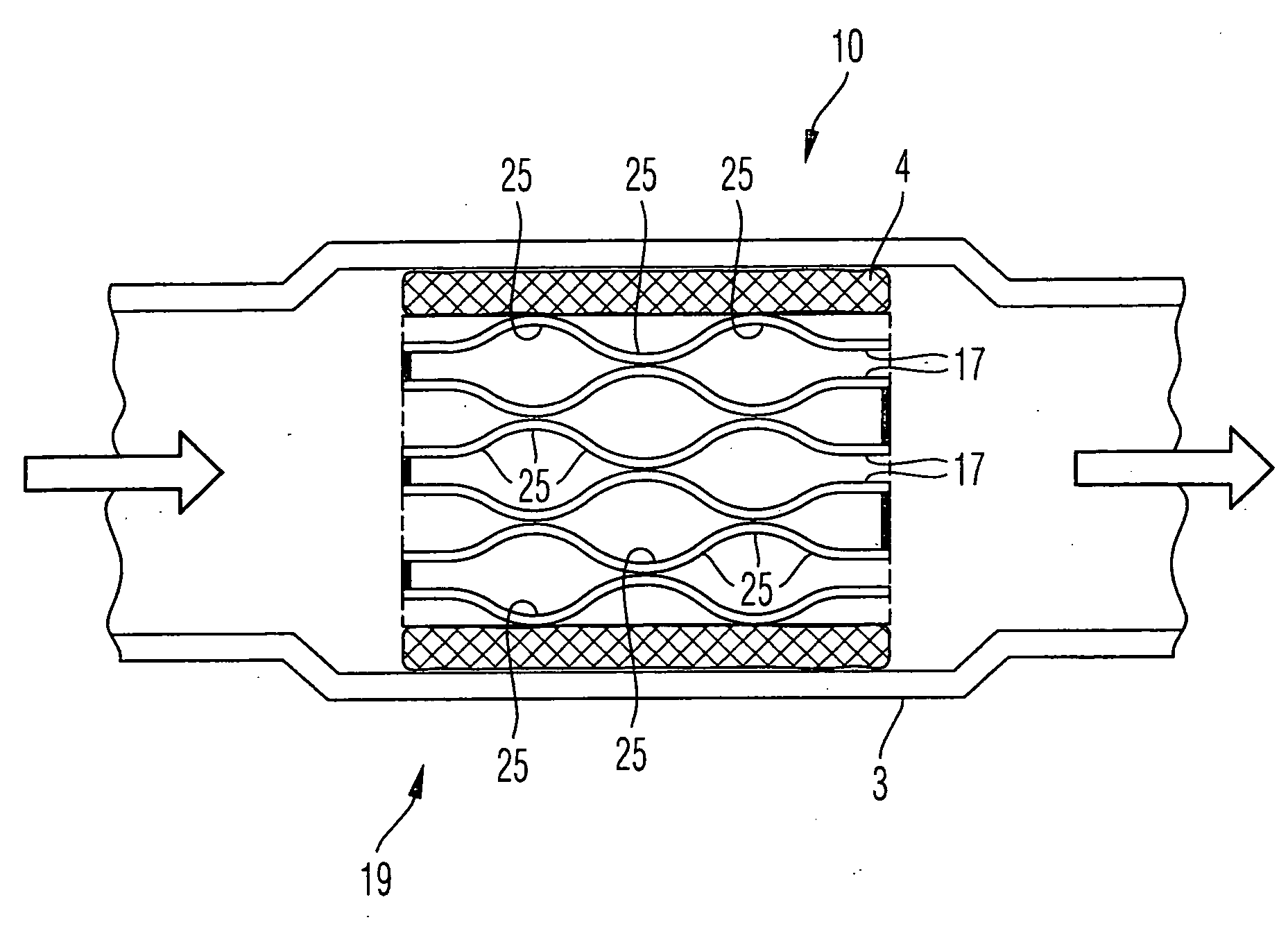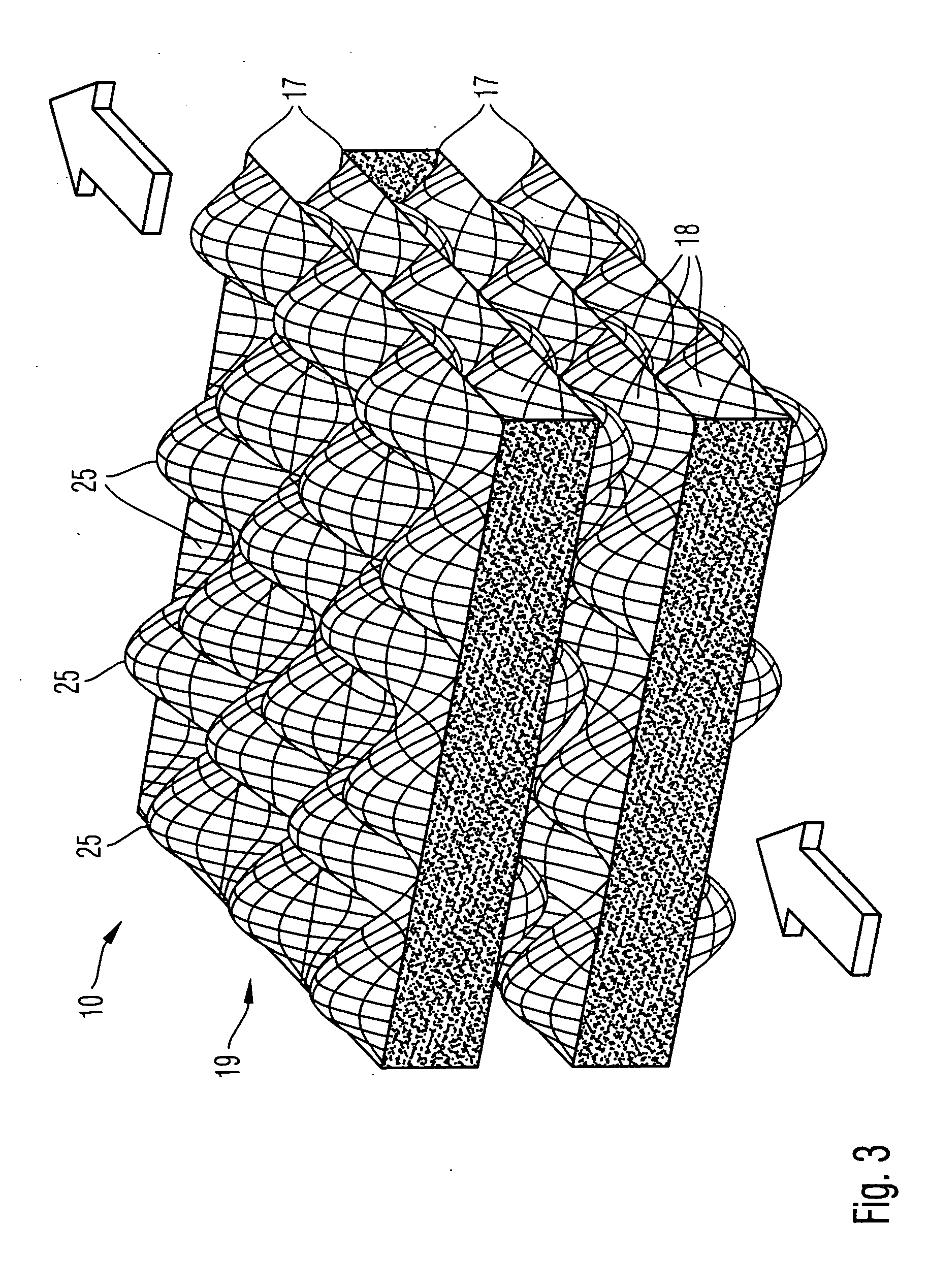Exhaust gas cleaning apparatus
a technology of exhaust gas and cleaning equipment, which is applied in the direction of lighting and heating equipment, physical/chemical process catalysts, and combustion engines which are operated with fossil fuels. it can solve the problems of inhomogenous regeneration of particulate filters, inability to manufacture conventional particulate filters, and inability to clean exhaust gas channels. it achieves the effect of avoiding local clogging, increasing the stability of material layers, and effective turbulence of exhaust gas
- Summary
- Abstract
- Description
- Claims
- Application Information
AI Technical Summary
Benefits of technology
Problems solved by technology
Method used
Image
Examples
second embodiment
[0083]FIG. 5 shows a perspective longitudinal cross section of a particulate filter 10a, which is the present invention.
[0084] In this embodiment the concave and convex surface areas 25a of the material layers 17a form continuous wave crests and wave troughs which expand substantially linearly. Wave crests and wave troughs of adjacent material layers 17a form an angle α between each other, the angle of which is about 70° in the example shown. A distance λ, i.e. a wave length, between two adjacent wave crests (wave troughs, respectively) is 2 mm, and a maximum deviation 2a of the wave crests and -troughs is 1 mm. By appropriate selection of a ratio of λ and a (relative wave length λ / a) a particular rigidity of the particulate filter structure may be achieved.
[0085] In FIG. 5 the material layers 17a are shown having a distance from each other in a stack 19a. However, the material layers 17a may be on top of each other in order to provide the particulate filter 10a with a particular s...
third embodiment
[0088]FIG. 7 shows a perspective view of a particulate filter 10b, which is the present invention.
[0089] The webs 29 shown in FIG. 6 are replaced in the particulate filter 10b shown in FIG. 7 by two adjacent material layers 17b of a stack 19b alternately connected to each other at the entry side and the exit side, respectively, by adhering or welding (e.g. seam welding), whereby exhaust gas flow channels 18b are again alternately closed at the entry side and open at the exit side, and open at the entry side and closed at the exit side, respectively.
[0090] It is possible, that the material layers 17b may also be, in addition to adhering, connected to each other by folding, or only by folding. For this, one end of a material layer, which is to be connected to an end of another material layer, is wrapped around the end of the other material layer, and is then clinchingly pressed to the other end.
fourth embodiment
[0091]FIG. 8 shows a perspective view of a particulate filter 10c, which is the present invention.
[0092] Two adjacent material layers 17c of a stack 19c are connected to each other integrally at the entry side and exit side, respectively, in this particulate filter 10c, by means of folding a material sheet.
[0093] FIGS. 9 to 12 show perspective views of particulate filters 10d, 10e, 10f and 10g, which are manufactured in accordance to an inventive method.
[0094] According to the method, a material sheet 17d made of a porous material being permeable to the exhaust gas is folded at fictional folding lines 31 which extend transversely to an extension direction of the material sheet 17d.
[0095] Then, the thus folded material sheet is layered in sections so that a stack 19d is formed. By this layering, exhaust gas flow channels 18d are provided. As in the previous embodiments, these exhaust gas flow channels 18d are alternately closed at the entry side and open at the entry side, and ope...
PUM
| Property | Measurement | Unit |
|---|---|---|
| angle | aaaaa | aaaaa |
| distance | aaaaa | aaaaa |
| distance | aaaaa | aaaaa |
Abstract
Description
Claims
Application Information
 Login to View More
Login to View More - R&D
- Intellectual Property
- Life Sciences
- Materials
- Tech Scout
- Unparalleled Data Quality
- Higher Quality Content
- 60% Fewer Hallucinations
Browse by: Latest US Patents, China's latest patents, Technical Efficacy Thesaurus, Application Domain, Technology Topic, Popular Technical Reports.
© 2025 PatSnap. All rights reserved.Legal|Privacy policy|Modern Slavery Act Transparency Statement|Sitemap|About US| Contact US: help@patsnap.com



